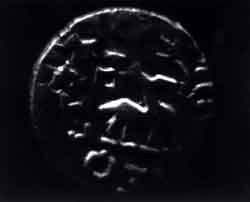
Puninds Coin, Obverse

Puninds Coin, Obverse
COINS GIVE EVIDENCE ON PUNINDA-KUNINDA TRIBE
There is a great confusion between the tribe of Kuninda and Puninda referred to in various literarysources. Some scholars identify the Puninda with Kuninda while another group of scholars have identified them as separate tribes and placed them somewhere in the Deccan region. Without any authentic finding, it has always remained a subject of controversy between the scholars and the historians. Recently, a hoard of Kuninda coins was found at Jalog in Shimla district, in Himachal Pradesh. The collection contains 193 silver and copper coins of Kuninda but one coin bears the name Puninda. This coin bears the same symbols and inscription as the Kuninda coins. The inscription reads ‘Raja Puninda Amogbhuits Maharajas’ in Brahmi script on the obverse but there is no Kharoshti legend on the reverse of the coin.
The symbols are thus: on the obverse are a deer to the right of a female figure (facing) and holding a flower in right hand and her left hand rests on the thigh with inscriptions written around. On the reverse is a five-arched hill in the centre surmounted by a Nandi-pada symbol, on the right is a tree in a railing and on the left two symbols. Below is a representation of a river (see photos) Each coin, circular is shape weighs 3.95 gm.
The significance of the find is that it establishes that Kuninda and Puninda are the same tribe, who ruled a considerable tract of north India during the period of 200 BC. to 200 AD. In Srimad Bhagavatam (2-4-18) they are associated with the Kiratas, Hunas, Andhras, Abhiras, Yavanas and Khasas. In Bengali recension of Ramayana, the Punindas appear both in south and in the north. The northern recension knows only of the northern Puninda. In Mahabaharata, they are known to have been defeated by Arjuna in his north and digvijaya campaign. Arjuna had to confront the monarchies of Puninda, Kalkuta and Amart at the start of his campaign. Some of these tribes are related to northern India particularly to the mountain region. Hence, it is clear that in literary source where the term Kulinda is used for Kuninda as we find on the coins, the same term Pulinda is applied for Puninda. It is believed that the term Pulinda is used for Kuninda with variation in pronunciation.
In Mahabarata we also find the term Pulinda and Kulinda used for the same tribe at different places. Moreover the same symbols are also noticed in both the coins. In Brhatsamhita, Varahamihira places the tribe in the north-eastern division along with teh Kashmerians, Kulutas and Sairindhas and speaks about the fate of Kulinda. The country of teh Kuninda is referred to by Ptolemy as Kulindrine. He locates it near the mountainous region where the Vipasa, Satadru, Yamuna and Ganga have their source. A. Cunningham has identified the Kuninda tribe with the present day Kunet of Kullu and Shimla. According to the ethnographic distribution and numismatics findings the Kunindas occupied a land at the foothill of Shiwalik between Yamuna and Satluj and the territory between the upper course of the Beas and the Sutluj. Their coins are also found in large part of Uttaranchal showing that they were an independent tribe during the period 2nd BC to 2nd AD.
The Kunindas probably disappeared from the political map of northern India sometime before 350 AD, for, they are not mentioned in the Allahabad pillar inscription of Samudragupta. There is also no other evidence of the continuation of their rule. it may thus be assumed that the Kuninda state did not survive for a longer period and was probably overpowered by the Yaudheyas.
As for the name of Amoghbhuti, the view of K/P. Jayaswal is agreeable that, Amoghbhuti is an official title of Kuninda ruler, which means ‘of unfailing prosperity’ because there is a wide variety of coins found in a period of more than 400 years of Kuninda rule. It is not possible that one king ruled for so long or that currency in the name of one king only was used.
Contributed by Hari Chauhan,
Himachal State Museum, Shimla




